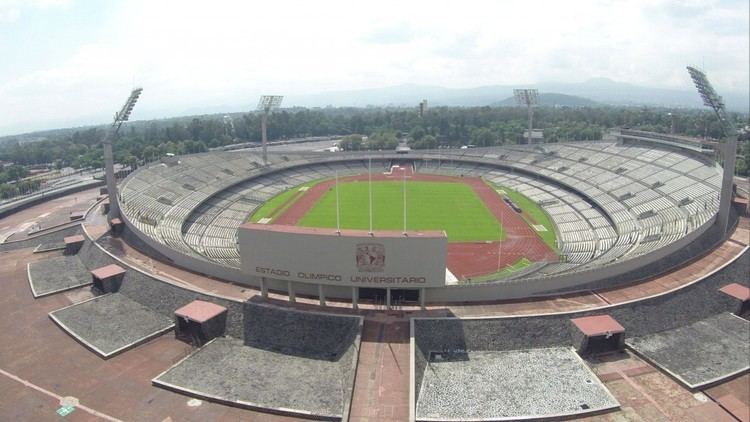Operator U.N.A.M. Surface Grass Opened 20 November 1952 Phone +52 55 5665 0403 | Field size 105 x 68 m Broke ground August 7, 1950 Capacity 48,297 | |
 | ||
Address Av de los Insurgentes Sur S/N, Universidad Nacional Autonoma de Mexico C.U., Cd. Universitaria, 04510 Ciudad de México, CDMX, Mexico Architects Augusto Pérez Palacios, Jorge Bravo Jiménez, Raúl Salinas Moro | ||
Rodrigo de buen la voz del estadio ol mpico universitario parte 1
Estadio Olímpico Universitario is a multi-purpose stadium located in Ciudad Universitaria, Mexico City. It was built in 1952 and at that time was the largest stadium in Mexico. This stadium has a capacity of 48,297. The first major event held in the stadium was the 1955 Pan American Games. During the 1950s and the 1960s this stadium was used mostly for college American football matches between the largest Mexican public universities at the time: UNAM and IPN. From the late 1950s it was used for football matches, some American football matches and athletics contests. It was named by Frank Lloyd Wright "the most important building in the modern America".
Contents
- Rodrigo de buen la voz del estadio ol mpico universitario parte 1
- goya estadio ol mpico universitario
- Architecture and art of the stadium
- References
The Olímpico Universitario hosted the 1968 Summer Olympics; for the event the seating capacity was increased from 70,000 to 83,700 spectators (without substantially modifying the original structure) to cover the IOC requirements for an Olympic stadium. It was the location of the track & field competitions, equestrian events, certain association football matches, the arrival of the marathon and the opening & closing ceremonies. This was the Olympics in which Tommie Smith and John Carlos protested against the treatment of black people in the United States by performing a black power salute during the medal ceremony for the 200m. The stadium also hosted several games of the 1986 FIFA World Cup, but the final match was played in the bigger Estadio Azteca in Mexico City.
The Tartan track was the first All-weather running track to be used in the Olympics. Such a track is now a requirement.
Now it is the home stadium of Club Universidad Nacional and American football team Pumas Dorados de la UNAM.
During the final matches of the Mexican football league between Club America and UNAM Pumas in 1985 the authorities of the UNAM Pumas allowed more spectators into Estadio Olímpico Universitario than the capacity allowed for the building. During the attempt of the fans to get to the pitch in one of the access tunnels (the tunnel number 29) a number of people got stuck and ended with the death of 11 people and several others injured.
This sport facility is part of the Ciudad Universitaria ("University City"), the main campus of the UNAM.
goya estadio ol mpico universitario
Architecture and art of the stadium
It is the work of architects Augusto Perez, Raul Salinas and Jorge Bravo Moro. The "Estadio Universitario, original name, was built specifically for the former practice of football.
On the east side of University Olympic Stadium, is a mural by Diego Rivera, called "The University, the Mexican family, peace and youth sports. In the construction of the relief in natural colored stones shows the university shield, with the condor and the eagle on a cactus. Under their wings outstretched, Rivera placed three figures representing the family: the father and the mother giving the dove of peace to his son. At the extremes are two gigantic figures that correspond to some athletes, male and female, who light the torch of Olympic flame. A huge feathered serpent, the symbolic image of the pre-Hispanic god Quetzalcoatl, complements the composition at the bottom.
Diego Rivera had planned to cover the entire outside of the stadium with designs similar to this, but the artist's death prevented him.
The asymmetric shape of the stands of the stadium-side with the more developed west-emphasizes the final composition of the joint project of the University City, which finished off its axis and principal, the stands closest to the Avenida Insurgentes, emphasizes the sense league stadium to the rest of the set.
Much like the Olympic cauldron on top of the Los Angeles Memorial Coliseum peristyle, the upper deck on one sideline is topped by an Olympic cauldron that was installed for the Olympic Games. The other sideline is topped by a press box.
